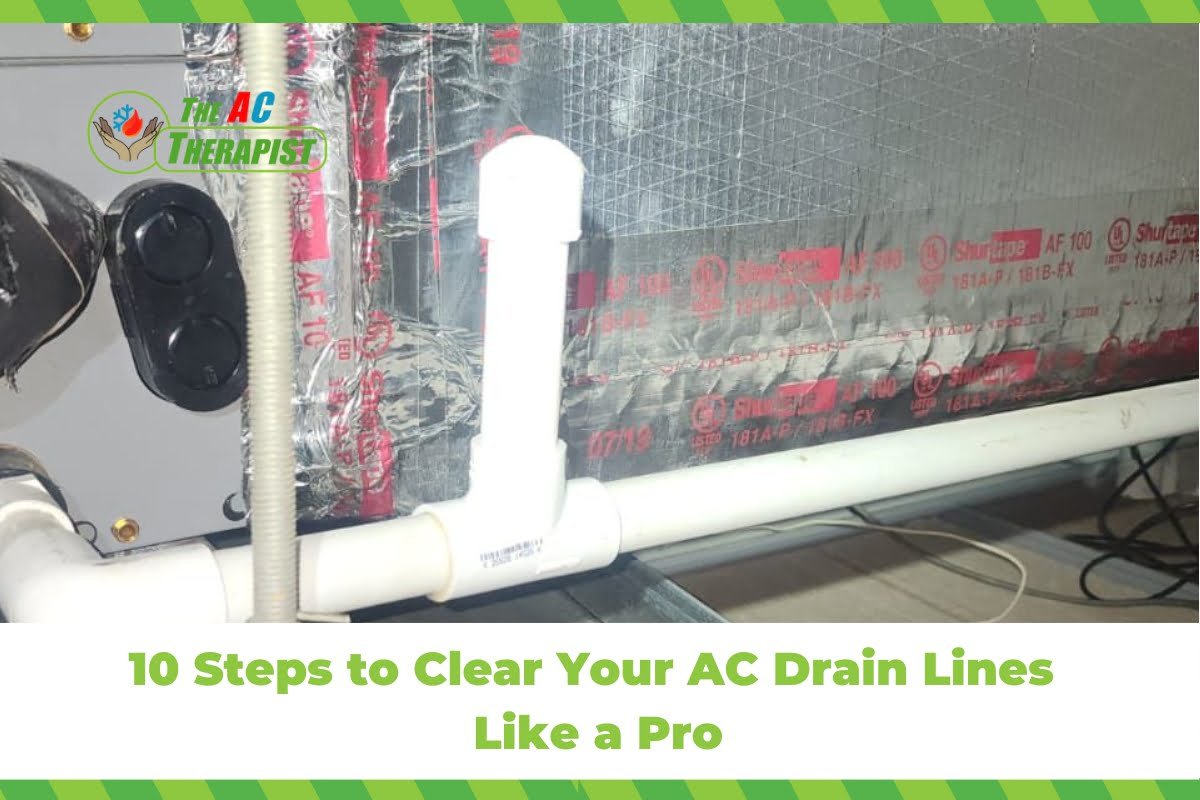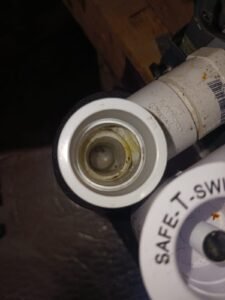10 Steps to Clear Your AC Drain Lines Like a Pro
Air conditioning systems have become an indispensable part of modern living, providing comfort during hot and humid weather. Behind the scenes of these cooling marvels, various components work together to ensure efficient operation. Among these components, AC drain lines are pivotal in managing moisture and preventing water damage. This comprehensive guide will explore the significance of AC drain lines, their components, common issues, and effective maintenance strategies to keep your AC system running smoothly.
What Are AC Drain Lines?
AC drain lines, also known as condensate drain lines, serve a critical function in air conditioning systems. During the cooling process, warm and humid air enters the evaporator coil. As the air cools down, moisture in the air condenses into water droplets that accumulate on the coil. This condensed water needs to be efficiently removed from the system to prevent water damage and mold growth. AC drain lines are responsible for channeling this excess water away from the system and out of your living space.
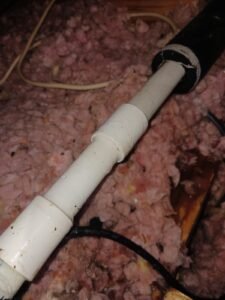
Components of AC Drain Lines
AC drain lines consist of several components that work in tandem to facilitate the removal of condensed water:
- Drain Pan: Located beneath the evaporator coil, the drain pan collects the condensed water. It is designed to capture the water and prevent it from dripping onto the floor or other sensitive areas.
- Drain Line Pipe: Connected to the drain pan, the drain line pipe transports the collected water away from the indoor unit to a suitable drainage location, such as a floor drain or an exterior area.
- P-Traps and Cleanouts: P-traps are U-shaped sections of the drain line that prevent sewer gases from entering the AC system. Cleanouts are access points along the drain line that allow for easy inspection, cleaning, and maintenance.
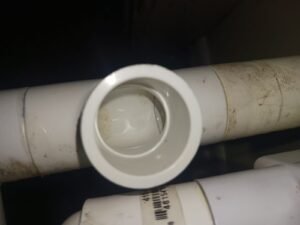
Why AC Drain Lines Matter
The AC drain line plays a critical role in the proper functioning and efficiency of your air conditioning system. Its importance lies in managing moisture and preventing water damage, as well as contributing to indoor air quality and energy efficiency. Here are the key reasons why the AC drain line is essential:
- Moisture Removal: During the cooling process, warm and humid air is drawn into the air conditioning system. As the air is cooled, moisture in the air condenses into water droplets on the evaporator coil. The AC drain line is responsible for collecting and directing this condensed water away from the system to prevent it from accumulating and causing damage.
- Water Damage Prevention: If the condensed water is not effectively removed from the system, it can lead to water leakage, which in turn can cause damage to your property. Water damage can result in structural issues, damaged walls, ceilings, and flooring, and even promote mold growth if left unchecked. The drain line prevents these potential issues by safely channeling water away from the system.
- Mold and Bacteria Prevention: Stagnant water in the drain pan or line can create an environment conducive to the growth of mold, bacteria, and algae. These microorganisms can negatively impact indoor air quality and potentially lead to health issues for occupants. A properly functioning drain line helps prevent the growth of these harmful agents.
- Indoor Air Quality: The presence of mold and bacteria from stagnant water can lead to poor indoor air quality. These contaminants can be circulated throughout your home, potentially causing respiratory problems, allergies, and other health issues. A clear and functional drain line contributes to maintaining clean and healthy indoor air.
- Energy Efficiency: A clogged or blocked drain line can impact the efficiency of your air conditioning system. When the drain line is obstructed, water may back up and hinder the cooling process. This can cause the system to work harder to achieve the desired temperature, leading to higher energy consumption and increased utility bills.
- Preventing System Shutdown: Some air conditioning systems are equipped with a float switch that detects water accumulation in the drain pan. If the water level becomes too high due to a clogged drain line, the float switch can trigger the system to shut down. This safety feature prevents water overflow and potential damage to the system.
- Longevity of Equipment: Water damage can lead to corrosion and deterioration of various components within the air conditioning system. By preventing water accumulation, the drain line contributes to the longevity and optimal performance of the equipment.
In essence, the AC drain line is a vital component that ensures proper moisture management, prevents water damage, maintains indoor air quality, and enhances the energy efficiency of your air conditioning system. Regular maintenance and attention to the drain line can help prevent clogs, blockages, and potential issues, allowing your system to operate effectively and efficiently.
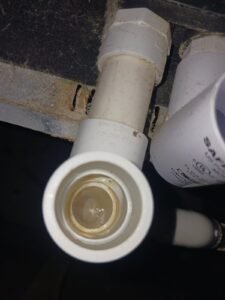
Common Issues with AC Drain Lines
Despite their importance, AC drain lines can encounter various issues over time:
- Clogs and Blockages: Dust, dirt, debris, and even mold can accumulate in the drain line, leading to clogs that restrict water flow.
- Algae and Mold Growth: Warm and moist environments provide ideal conditions for the growth of algae and mold, which can thrive in the drain pan and line.
- Drain Line Leaks: Cracks or damage to the drain pan or drain line can result in leaks, potentially causing water damage to your property.
Signs of a Clogged AC Drain Line
Identifying a clogged AC drain line early can help prevent further damage and system inefficiencies. Look out for these signs:
- Water Leakage: Visible water puddles around the indoor unit or along the drain line path can indicate a clog or blockage.
- Musty Odors: Stagnant water and mold growth can produce musty odors that spread throughout your living space.
- Reduced Cooling Efficiency: A clogged drain line can lead to decreased cooling efficiency as the evaporator coil struggles to function optimally.
How much water should be coming from the AC drain line?
The amount of water that should be coming from your AC drain line can vary based on factors such as the humidity level, the cooling load, and the efficiency of your air conditioning system. Generally, a properly functioning AC drain line should expel a steady but moderate flow of water when the system is running.
During normal operation, you might expect to see anywhere from half a gallon to several gallons of water per hour being discharged from the AC drain line. This water is the result of condensation forming on the evaporator coil and is collected in the drain pan, which then drains through the drain line.
If you notice a significant increase in the amount of water coming from the drain line, it could indicate an issue such as a clogged drain line, a malfunctioning float switch (which can indicate an overflowing drain pan), or an overly humid indoor environment. On the other hand, if you observe very little or no water coming from the drain line while the AC is running, it could indicate a potential clog or blockage.
It’s important to monitor the water flow regularly and be attentive to any sudden changes or abnormalities. If you’re unsure whether the amount of water is within a normal range, or if you suspect there might be a problem with the drain line, it’s a good idea to contact a professional HVAC technician for an inspection and appropriate maintenance.
Maintaining AC Drain Lines
Regular maintenance is key to preventing AC drain line issues. Follow these steps to keep your AC drain lines clear:
- Regular Inspections: Inspect the drain pan, drain line, and cleanouts for any signs of buildup, algae growth, or leaks.
- DIY Maintenance Tips:
- Pour a mixture of equal parts white vinegar and water down the drain line to help prevent algae growth.
- Ensure the drain line is properly aligned and secured to prevent kinks or bends that could impede water flow.
- Clean the drain pan using a mild detergent and water to remove dirt and debris.
- Professional Maintenance:
- Enroll in a professional HVAC maintenance plan to ensure regular check-ups and cleaning of your AC system, including the drain lines.
- A qualified technician can perform a thorough inspection, clear any clogs, and address any potential issues.
Steps to Clear AC Drain Lines
To unclog your AC drain line, follow these steps. If you’re not comfortable doing this yourself or if the clog is severe, it’s recommended to contact a professional HVAC technician for assistance.
Materials You’ll Need:
- Wet/dry vacuum
- Towels or rags
- Bucket
- Pipe brush or pipe cleaner
If you encounter a clogged AC drain line, here’s a step-by-step guide to clearing it:
- Safety Precautions: Turn off the AC system’s power to ensure your safety during the maintenance process.
- Gather Necessary Tools: You’ll need a wet/dry vacuum, towels, a bucket, a pipe brush or cleaner, and potentially a funnel.
- Turn Off the AC System: Shut off the power to the air conditioning system to prevent any accidents while working on the drain line.
- Locate the Drain Line: Identify the drain line’s exit point, which is usually near the indoor unit or furnace.
- Remove the Cleanout Cap: If applicable, remove the cleanout cap from the drain line’s access point. Be prepared for some water to drain out.
- Create Suction with a Wet/Dry Vacuum: Attach the vacuum hose to the drain line’s opening and create suction to dislodge the clog.
- Use a Pipe Brush or Cleaner: Gently insert a pipe brush or cleaner into the drain line to further remove any remaining debris.
- Check Drain Line Flow: After clearing the clog, ensure that water flows freely through the drain line by pouring water down the drain pan and observing its exit.
- Replace Cleanout Cap: Once the drain line is clear, replace the cleanout cap securely.
- Turn On the AC System: Restore power to the AC system and monitor the drain line for proper drainage.
Remember that prevention is key to avoiding future clogs. Regular maintenance, such as pouring a mixture of equal parts white vinegar and water down the drain line to prevent algae growth, can help keep your AC drain line clear.
If you’re unsure about any step or if the clog persists, it’s advisable to contact a professional HVAC technician for assistance. They have the expertise and tools to handle more complex clogs and ensure that your AC system is functioning optimally.
Preventive Measures for AC Drain Lines
Preventing future clogs and issues with AC drain lines involves ongoing maintenance:
- Installing Algae Tablets: Algae tablets can be placed in the drain pan to help prevent algae growth and clogs.
- Regularly Changing Air Filters: Clean or replace air filters as recommended to maintain proper airflow and reduce the likelihood of debris entering the drain line.
- Keeping the Area Around the System Clean: Dust and debris can find their way into the AC system, potentially leading to clogs. Regularly clean the area around the indoor unit and outdoor condenser.
Professional Maintenance and Services
Professional maintenance is crucial for ensuring the longevity and optimal performance of your AC system, including the drain lines. Enrolling in an HVAC maintenance plan offers several benefits:
- Regular Tune-ups: HVAC technicians can perform thorough inspections, identify potential issues, and conduct necessary cleaning to prevent clogs and blockages.
- HVAC Maintenance Plans: Many HVAC companies offer maintenance plans that include scheduled visits, cleaning of drain lines, and discounts on repairs.
AC drain lines are unsung heroes of air conditioning systems, managing moisture and preventing water damage to your property. Understanding the components, potential issues, and maintenance steps associated with AC drain lines empowers homeowners to take proactive measures to keep their cooling systems optimal.
Where are AC drain lines located?
AC drain lines are typically located near the indoor air handler unit or furnace of your air conditioning system. Specifically, the drain line is connected to the evaporator coil, which is located within the indoor unit. The drain line’s exit point is usually at the bottom of the indoor unit, and it leads to the outside of your home or a suitable drainage location.
In many cases, you’ll find the drain line exiting your home near the outdoor condenser unit or near a floor drain. The drain line may also connect to a drain pan, which collects the condensed water from the evaporator coil and directs it toward the drain line.
It’s important to note that the exact location of the drain line can vary based on the design and layout of your air conditioning system. Regular inspections and maintenance can help you easily locate the drain line and ensure that it’s functioning properly to prevent water damage and other issues.
Are there 2 AC drain lines?
Yes, some air conditioning systems have two AC drain lines. These are commonly referred to as primary and secondary drain lines. Here’s an explanation of each:
- Primary Drain Line: The primary drain line is the main pathway for removing condensed water from the air conditioning system. It connects to the evaporator coil inside the indoor air handler or furnace and carries the water away from the unit to a drainage location outside your home or to a floor drain.
- Secondary Drain Line: The secondary drain line serves as a backup in case the primary drain line becomes clogged or blocked. If the primary drain line becomes obstructed, the secondary drain line prevents water from overflowing and causing damage. The secondary drain line is typically installed above the primary drain line and may have its own exit point outside your home.
The presence of a secondary drain line is an important safety measure to prevent water damage in case the primary drain line becomes compromised. Regular maintenance and inspections are crucial to ensure both the primary and secondary drain lines are clear and functioning properly. If you notice water dripping from the secondary drain line, it could indicate an issue with the primary line that needs to be addressed.
Safeguarding Comfort and Quality: The Vital Role of AC Drain Lines, Backed by The AC Therapist’s Expertise
In conclusion, AC drain lines are an often overlooked yet indispensable part of any air conditioning system. As we’ve learned, these unassuming components play a crucial role in managing moisture, preventing water damage, maintaining indoor air quality, and promoting energy efficiency. The proper functioning of AC drain lines is essential for the overall performance and longevity of your cooling system.
When considering the significance of AC drain lines, it’s important to recognize the role that preventive maintenance and professional services play in ensuring their effectiveness. Regular inspections, DIY maintenance, and the guidance of experienced technicians can help keep drain lines clear, preventing clogs and blockages that could lead to water damage or compromised indoor air quality.
For residents and businesses in the Tampa Bay area, The AC Therapist stands as a trusted partner in maintaining optimal HVAC performance. With their expertise in air conditioning services, including AC drain line maintenance, they offer tailored solutions to keep your cooling system running smoothly. Whether it’s AC repair, installation, maintenance, or addressing issues with drain lines, The AC Therapist’s team is dedicated to providing reliable and efficient services that ensure your comfort and peace of mind.
By understanding the importance of AC drain lines and partnering with professionals like The AC Therapist, you’re taking proactive steps to ensure a cool and comfortable environment while safeguarding your property from potential water damage. Remember, investing in the proper care of your AC system today can lead to more efficient and trouble-free cooling for years to come.

